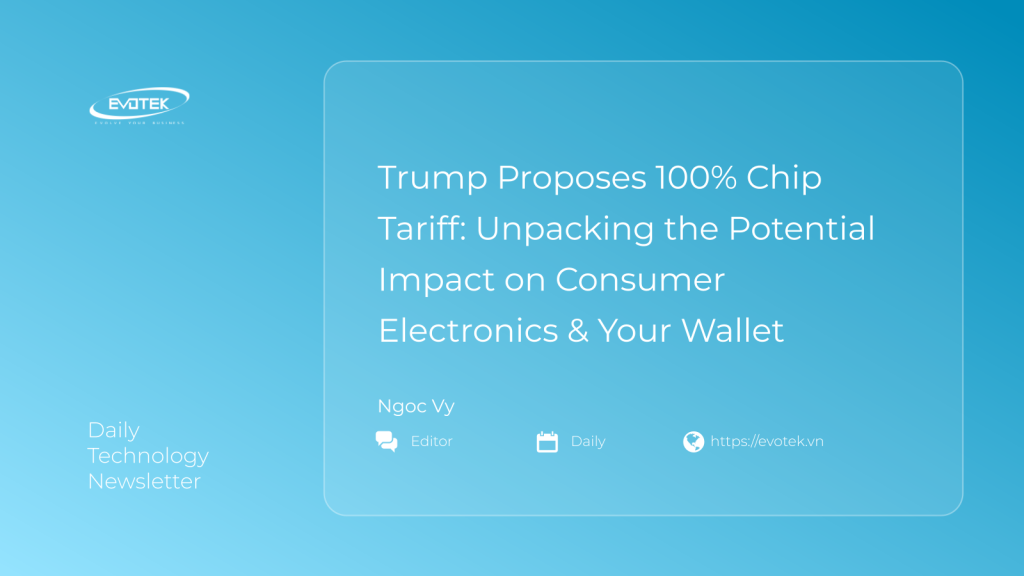President Donald Trump has announced plans to implement a sweeping 100% tariff on imported computer chips, a move that could send ripples across the global economy and directly affect American consumers. While specific details remain somewhat opaque, experts are sounding the alarm about potential consequences, including increased product prices and a potential slowdown in manufacturing. From the smartphone in your pocket to the vehicle in your driveway, modern life is deeply intertwined with these tiny silicon brains. As Zac Rogers, an associate professor of operations and supply chain management at Colorado State University, highlights, “If you look at the industries that need chips, it’s almost everything. You probably have at least 100 chips involved in the things you’ve done today.”
Understanding the Proposed Chip Tariff
The tariff, unveiled by former President Trump during an Oval Office event on August 6th, includes a significant caveat: an exemption for companies committed to establishing or expanding chip manufacturing facilities within the United States. However, beyond this broad outline, much remains unclear. Key questions persist regarding the tariff’s effective date and its precise impact on a vast array of chip-containing goods, such as laptops and gaming consoles. Jason Miller, a professor of supply chain management at Michigan State University, emphasizes this ambiguity: “There are a lot of caveats. Until we see the exact details of what harmonized system codes are covered, we can’t fully understand the implications.”
The United States is a significant player in semiconductor production, annually exporting approximately $58 billion worth of chips. Yet, Miller points out a crucial distinction: the U.S. excels in producing higher-end chips, while many lower-end, generic semiconductors are typically imported from countries like Malaysia. Taiwan, meanwhile, is a primary source for “super high-end” chips. The nation collectively imports around $60 billion in semiconductors each year. “The U.S. is not as cost-competitive at producing the lower-end, generic semiconductors,” Miller explains, suggesting that prioritizing high-end production aligns with the nation’s competitive advantage.
While expanding domestic chip production is a logical long-term goal, especially following initiatives like the CHIPS and Science Act of 2022, experts caution that building new facilities and nurturing a skilled talent pipeline is a time-intensive process. Rogers warns, “We can’t scale up fast enough to totally fulfill our own demand. If we just slap all of these costs onto firms, it might actually slow down the progress that we’re making.”
What This Could Mean for Your Wallet
While some experts believe the financial burden of these chip tariffs on manufacturers might not be as severe as other historical tariffs, such as those on steel, aluminum, or automobiles, the new levy will undoubtedly add to existing cost pressures for businesses. As Miller notes, “It’s not deflationary, by any means,” though he concedes that predicting precise consumer inflationary impacts is “truly impossible” until more specific details emerge.
John Mitchell, president and CEO of the Global Electronics Association, anticipates that tariffs will inevitably push up prices for a broad spectrum of goods, including laptops, household appliances, vehicles, and essential medical devices. He highlights previous experience, stating, “More than 60% of our member companies report that past tariffs have raised their costs and delayed production.”
For industries like automotive, where chips typically represent a smaller fraction of overall production costs, the tariff is seen as “yet another cut,” according to Ivan Drury, director of insights at automotive research site Edmunds. Automakers like General Motors and Stellantis have already reported significant financial hits from existing tariffs. While manufacturers have largely absorbed these costs to date, Drury questions how long this can continue before prices are passed on to consumers. “Their shareholders aren’t going to be happy with this forever,” he comments.
A particularly vulnerable group could be used car owners. Higher repair costs due to more expensive chips could be directly passed on, potentially leading to increased insurance premiums. Drury describes this as a “snowball effect,” where initial tariffs could trigger a cascade of rising expenses.
Could We See Product Shortages?
Beyond price hikes, another significant concern for consumers is the potential for product shortages. The memory of the COVID-19-era semiconductor shortage, which severely impacted the availability of new cars, computers, and gaming consoles, remains fresh. While this proposed tariff is not expected to trigger a crisis of that same magnitude, experts like Rogers warn that elevated import costs could compel some companies to scale back production. For instance, automaker Stellantis has already paused production at certain plants to mitigate tariff exposure, contributing to a recent decline in car shipments.
“I think we can see shortages all over the place,” Rogers states. He clarifies the distinction from the 2021 crisis: “It may not be as bad as 2021 because then, we couldn’t get the chips. This, we’ll just have to pay more for them. But if we pay more, we buy less.” This basic economic principle suggests that while chips might be available, their increased cost could lead to reduced demand and, consequently, reduced supply as manufacturers adjust.

 日本語
日本語 한국어
한국어 Tiếng Việt
Tiếng Việt 简体中文
简体中文